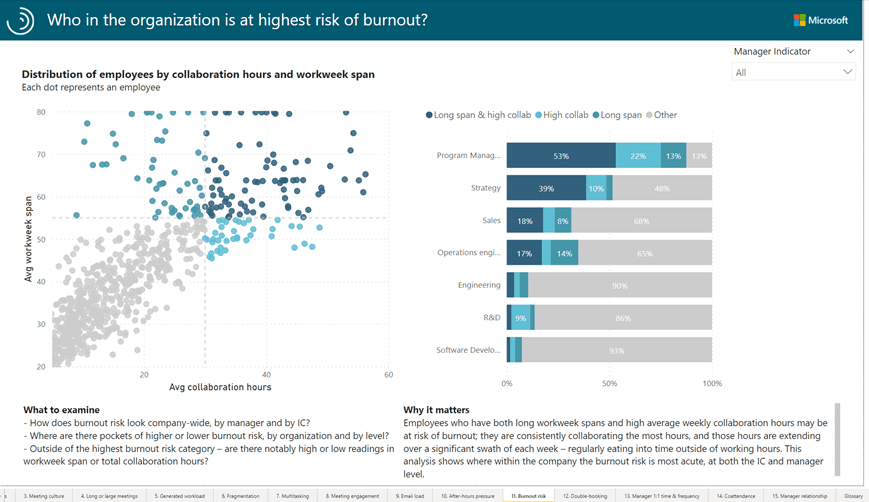
Wouldn’t it be great if you could work out where your time was being spent? Who are you spending lots of time collaborating with and if it is your most critical task?
Imagine a personal assistant that reminds you what meetings you have coming up, provides you with relevant content and asks if you’ve sent the information you promised to a colleague last week?
Viva Insights, a productivity and wellbeing capability, offers this and so much more. Viva Insights provides individuals, managers and leaders with insights and actionable recommendations to help everyone to focus, prioritise their time and to nurture individual wellbeing.
On this last point, we can’t afford to not care about wellbeing. At a time when 85% of people believe their wellbeing has declined and 56% believe job demands have increased 1 it’s clear there’s a problem. For Australians, it would seem we’re experiencing a sense of burnout more than workers from a host of countries including Canada, the US, UK, China and Germany 2.
What is Viva Insights?
Viva Insights is one of four capabilities in Microsoft’s Employee Experience Platform – Microsoft Viva. If you haven’t heard about it already, you can check out blogs from Matt, Rachel and myself.
Viva Insights provides both ‘personalised insights’ and ‘actionable recommendations’ for individuals and leaders. At an organisational level – Viva Insights provides an aggregated view and real-time pulse check on things like meeting culture, manager effectiveness, which teams are at risk of burn out, and who’s generating the biggest workload.
Insights are collected based on user behaviour, aggregated, and shared as information to help an individual to understand their work patterns and where they can make changes to support their wellbeing and be more impactful. It helps managers understand patterns within their team which may be leading to stress and burnout; and for leaders, information to understand work patterns and behaviours across the business. Critically, the information is anonymised, protecting the privacy of individuals whilst providing the data needed for managers and leaders to address challenges head on.
Actionable recommendations are provided to individuals about their own work behaviours with suggestions on changes they can make to care for their wellbeing and manage their attention. Manager recommendations provide guidance on actions they need to take to connect with their team and to develop plans to improve collaboration and wellbeing. All of this rolls up to an organisational dashboard to enable leaders to make positive changes to overcome challenges within the business.

What’s included?
Viva Insights puts the power of information into everyone’s hands, so let’s look at the different role types.
Individuals
As an individual I may enjoy the flexibility of working from home, but I also need the ability to separate work and life and to stay connected with my colleagues and networks.
For the individual this includes:
- Viva Insights in Teams – guidance on how to stay connected, the ability to block focus time, headspace for guided meditation and a virtual commute to wrap up your day and plan for the day ahead.
- Viva Insights with Outlook – guidance on preparing for upcoming meetings, reminders on commitments or requests you’ve made and inline suggestions to assist with composing emails and scheduling meetings.
- Analytics dashboard – statistics about how you’ve spent your time and work habits. The ability to explore who and how you’re collaborating.
Managers
Managers want to support their teams to focus on what’s important, which requires time spent with individuals to provide coaching and support. They need to carve out time, but also to identify where meeting behaviours and work hours are creating the risk of burnout.
For managers this includes:
- Team impact – guidance on how your habits impact the team with suggestions to send praise and behaviours to protect your team’s quiet time.
- Engagement – reminders to complete tasks you committed to, or the team has asked of you.
- Development – setting aside 1:1 time for coaching, mentoring and support.
- Demonstrating good habits – guidance on good meeting habits like managing the length of the meeting, multi-tasking, joining on time and preventing meeting overlaps; and options to schedule no-meeting days to allow for focus time.
Leaders
As a leader I’m responsible for ensuring the business can continue to operate holistically; and we have the resources in place where we need them in the business, or that we’re adjusting within the parts of the business which seemed overwhelmed with work.
For leaders this includes:
-
- Organisational resilience – provides an insight into the organisation’s ability to respond to changes and refocus staff on new employees based on information about working hours, manager and employee engagement, team cohesion and conflicting priorities.
- Boost engagement – shows leaders about collaboration patterns across the organisation and where more or less time should be spent in employee coaching and development, creating capacity, or empowering employees to operate more autonomously such as independence to attend meetings without their managers present.
- Improve agility – through driving more effective meetings, and patterns of cross organisational collaboration to facilitate decision making.
- Foster innovation – offers information about the extent to which employees can protect time for learning, and deeper thinking to generate new ideas and solutions.
- Operational effectiveness – guidance on small changes which can be made to improve collaboration practices such as attention during meetings and capacity to do work outside of dedicated collaboration.
- Accelerate change – identifies how networks are influencing others within the organisation and can be leveraged to drive the adoption of technology and have scale to promote change efficiently.
- Transform meeting culture – recommendations on reducing unnecessary and even bad meeting practices which inhibit productivity and ways to promote good meeting behaviour.
- Increase customer focus – information into how much time is available for collaboration with customers and external stakeholders which can be used to make decisions on work priorities and practices to enable more customer focus.

Viva Insights and Glint
Glint is a people success platform built on a new approach that helps organizations increase employee engagement, develop their people, and improve business results. Together with Viva Insights, organisations can build ongoing feedback mechanisms which enable them to stay in-tune with employee sentiment including topics like culture, diversity and inclusion and development. Leveraging artificial intelligence, insights are offered to surface key areas for improvement and better understand underlying factors which may be leading to issues.
What is most powerful about this partnership is how feedback results are combined with Viva Insights, offering further evidence and guidance on the habits and work patterns which are working well, or need improvement. Managers are provided with guidance on actions they can take to act on feedback and learning content from LinkedIn to enhance skills.
Overall, this is a partnership which aims to provide organisations with a pulse reading from their organisation, with evidenced based data and research-based guidance on taking action to mature work practices.
How do I get started?
To start your journey with Viva Insights, I recommend the following:
- Review the data – start leveraging the data available to you from Viva Insights to understand where time is being spent collaborating, understanding work patterns and for individuals to start monitoring their wellbeing.
- Identify key challenges and priorities – based on the insights and actionable recommendations, identify where individuals, managers and leaders could most benefit from change. For example, if there is a pattern of large and long meetings, prioritise efforts to improve meeting effectiveness. Decide at an organisational and team level which areas will be focussed on.
- Develop a plan – develop a plan inclusive of key stakeholders and activities who will assist to bring awareness to the new ways you plan to work, identify barriers to the change, and rollout communications and training to enable the organisation to adopt the change. Critically, walk the talk by demonstrating the new behaviours yourself as a leader or manager.
- Reinforce – celebrate and recognise the success of individuals and teams who are demonstrating the new habits, share stories about how they achieved a change, review and report on data and changes forums where decisions can be made which support the desired behaviour change, encourage continuous learning by providing resources and encouraging the use of learning content like Viva Learning.
4 things I love about Viva Insights
There are many things I love about Viva Insights but if I had to choose my top 4, they would be:
- Reminders – I’m a pretty good list maker, but I don’t always get it right. The Viva Insights dashboard and daily briefing email remind me.
- Focus time – the ability to set up a plan to get work done. I use this for things like preparing for presentations and workshops or writing customer reports.
- Managing stress – for many years now, I’ve listened to music to help me focus. I’ve found it also helps me to reduce my stress and anxiety as I work too. The Headspace focus music seems to have the right number of beats to help me relax while I work. I think maybe I even type to the rhythm!
- Supporting teams – the ability for managers to set up no meeting periods for their team.
How can we help?
Engage Squared is a strategic partner to Microsoft, supporting customers adopting the new Employee Experience with Viva. We are the Microsoft 2021 Partner of the Year with gold status across 7 capability areas.
As one of a few Microsoft Preferred partners for Viva, we can help your organisation use insights to enhance the employee experience. View our Viva Insights quick-start offer here.
References
2 Resetting Normal | Burnout Might Be the New Worker Pandemic (adecco.com.au)